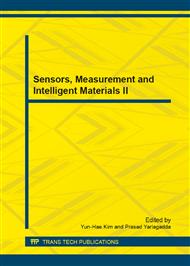[1]
Ha T. H., Muralidharan S., Bae J. H., et al. Role of sensors in corrosion monitoring in concrete structures: the state of the art[J]. Sens mater, 2004, 16(3), 133-158.
Google Scholar
[2]
Myrdal R. The electrochemistry & characteristics of embeddable reference electrodes for concrete (EFC43)[M]. Woodhead publishing, CRC press, New York, (2007).
DOI: 10.1533/9781845692551.13
Google Scholar
[3]
Ansuini F. J. and Dimond J. R. Long term field tests of reference electrodes for concrete-ten year results[C]. Corrosion2001, paper No. 296, NACE international, Houston, TX, USA, (2001).
Google Scholar
[4]
ASTM Committee. Standard Test Method for Half Cell Potentials of Reinforcing Steel in Concrete (G01. 14. ASTM C876, American National Standard) [S]. West Conshohocken, Annual Book of ASTM Standards, (1999).
Google Scholar
[5]
Qiao G, Xiao H, Hong Y. and Qiu Y. Preparation and characterization of the solid-state Ag/AgCl reference electrode for RC structures[J]. Sensor Review, 2012, 32(2), 118-122.
DOI: 10.1108/02602281211209400
Google Scholar
[6]
Villela T, Souza A, Abdel-Rehim H. Silver/silver chloride and mercury/mercurous sulfate standards electrodes confiability[J]. Corrosion, 2004, 60(4), 342-345.
DOI: 10.5006/1.3287740
Google Scholar
[7]
Duffó, G. S., Farina, S. B., and Giordano, C. M. Embeddable reference electrodes for corrosion monitoring of reinforced concrete structures[J]. Materials and corrosion, 2010, 61(6), 480-489.
DOI: 10.1002/maco.200905346
Google Scholar
[8]
Duffó G S, Farina S B, Giordano C M. Characterization of solid embeddable reference electrodes for corrosion monitoring in reinforced concrete structures[J]. Electrochimica Acta, 2009, 54(3), 1010-1020.
DOI: 10.1016/j.electacta.2008.08.025
Google Scholar
[9]
Muralidharan, S., Ha, T. H., Bae, J. H., Ha, Y. C., Lee, H. G., Park, K. W., & Kim, D. K. Electrochemical studies on the performance characteristics of solid metal–metal oxide reference sensor for concrete environments[J]. Electrodes and Actuators B: Chemical, 2006, 113(1), 187-193.
DOI: 10.1016/j.snb.2005.02.052
Google Scholar
[10]
Muralidharan, S., Saraswathy, V., Berchmans, L. J., Thangavel, K., & Ann, K. Y. Nickel ferrite (NiFe2O4): A possible candidate material as reference electrode for corrosion monitoring of steel in concrete environments[J]. Electrodes and Actuators B, Chemical, 2010, 145(1), 225-231.
DOI: 10.1016/j.snb.2009.11.071
Google Scholar
[11]
Muralidharan, S., Ha, T. H., Bae, J. H., Ha, Y. C., Lee, H. G., & Kim, D. K. A promising potential embeddable sensor for corrosion monitoring application in concrete structures [J]. 2007, Measurement, 40(6), 600-606.
DOI: 10.1016/j.measurement.2006.09.008
Google Scholar
[12]
Muralidharan, S., Ha, T. H., Bae, J. H., Ha, Y. C., Lee, H. G., Park, K. W., & Kim, D. K. Electrochemical studies on the solid embeddable reference electrodes for corrosion monitoring in concrete structure[J]. Materials Letters, 2006, 60(5), 651-655.
DOI: 10.1016/j.matlet.2005.09.058
Google Scholar
[13]
Muralidharan S., Saraswathy V., Thangavel K., et al. Electrochemical studies on the performance characteristics of alkaline solid embeddable sensor for concrete environments[J]. Sensors and Actuators B: Chemical, 2008, 130(2), 864-870.
DOI: 10.1016/j.snb.2007.10.059
Google Scholar
[14]
Lu S, Ba H.J. and Yang Y.Z. MnO2 reference electrode for monitoring corrosion in concrete structure[J]. Journal of wuhan university of technology, 2009, 31 (2). 42-45.
Google Scholar
[15]
Subramanian V., Zhu H., Vajtai R., et al. Hydrothermal synthesis and pseudocapacitance properties of MnO2 nanostructures[J]. The journal of physical chemistry B, 2005, 109(43), 20207-20214.
DOI: 10.1021/jp0543330
Google Scholar
[16]
Minakshi M. Examining manganese dioxide electrode in KOH electrolyte using TEM technique[J]. Journal of the electroanalytical chemistry, 2008, 616(1), 99-106.
DOI: 10.1016/j.jelechem.2008.01.011
Google Scholar
[17]
Cahoon N C. The influence of hydrogen ion concentration on the potential of african manganese dioxide[J]. Transactions of the electrochemical society, 1935, 68(1), 177-185.
DOI: 10.1149/1.3493866
Google Scholar
[18]
Johnson R. S., and Vosburgh W. C. The reproducibility of the manganese dioxide electrode and the change of electrode potential with pH[J]. Journal of the electrochemical society, 1952, 99(8), 317-322.
DOI: 10.1149/1.2779743
Google Scholar
[19]
Wei J., Fan L., Dong R.Z., et al. A kind of reference electrode: CN102175734, (2013).
Google Scholar


